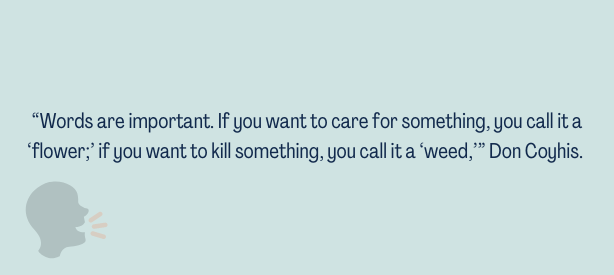What We Say Determines What We Do: Stigma and Substance Use Disorder
Written by Amanda Brooks, LCSW, CADC Owner, Brooks Integrated Health Solutions

Patients with substance use disorder (SUD) are seeking to tackle the very real chronic disease of addiction. Supporting the recovery journey of patients seeking SUD treatment allows providers and care teams the opportunity to observe the deep commitment that patients have for their health, their families, and their communities. Yet for many on the outside peering in they cannot look past the addiction to see patients as individual humans with individual struggles and individual successes. Instead, they are seen through the lens of their incarcerations, problematic behaviors, substance use, and mental health disorders. It is through this lens that individuals with mental health and substance use disorders are represented in dramatized, made-for-TV films, that only further ingrained beliefs about individuals with SUD. And this is what makes substance use disorder so challenging to treat.
Each year about 6% of the US population age 12 and over [1] will experience a substance use disorder, but less than 2% of people who need treatment for their SUD will actually receive it. [1] While there are many factors that contribute to why a person may or may not seek treatment, social and personal stigma are both significant contributing factors, and each play in to the other. [2] Social stigma, whether conscious or unconscious, is represented in the beliefs that society hold about individuals who use substances. Rooted in fear, judgement, and “othering,” these beliefs contribute to the differential care that individuals who use substances experience when seeking health care services. Through constant social shaming, individuals who use substances begin to internalize and identify with this “othering” and believe that they are not worthy of recovery. We now find ourselves in a constant loop of shaming and substance using.
The most basic way we can begin to address this social and personal stigma is by focusing on the language we use to talk about addiction and people with SUD.
“Words are important. If you want to care for something, you call it a ‘flower;’ if you want to kill something, you call it a ‘weed,’” Don Coyhis.
The language we use to talk about SUD is often very negative and unkind; think “addict” or “junkie” vs “person with addiction,” or someone being “clean” or “dirty” based on their current substance using status. If language effects how we feel, and ultimately then how we treat others, we can’t begin to tackle the stigma of SUD without taking time to address the words we use. It is then that we can allow ourselves to be open to the stories of individuals who use substances and those in recovery to humanize them and their experiences.
Every one of us holds our own personal biases based on our personal and familial experiences. Stigma exists because we allow ourselves to internalize these biases without question. Today, I present a challenge to you. Question your biases. Challenge your beliefs. Listen to the story of someone you do not know. And slowly, you may find that your beliefs begin to change. And suddenly, the world becomes a much kinder place.
Sources
- Substance Abuse and Mental Health Services Administration (SAMHSA). (2019, August). Key Substance Use and Mental Health Indicators in the United States[Review of Key Substance Use and Mental Health Indicators in the United States]. Substance Abuse and Mental Health Services Administration. https://www.samhsa.gov/data/sites/default/files/cbhsq-reports/NSDUHNationalFindingsReport2018/NSDUHNationalFindingsReport2018.pdf
- R Hammarlund, KA Crapanzano, L Luce, L Mulligan, KM Ward. (2018, November). Review of the Effects of Self-Stigma and Perceived Social Stigma on the Treatment-Seeking Decisions of Individuals with Drug- and Alcohol-Use Disorders. Substance Abuse Rehabilitation. https://www.ncbi.nlm.nih.gov/pmc/articles/PMC6260179/

